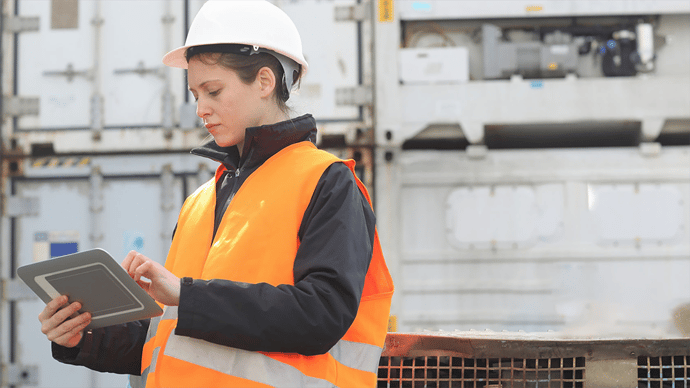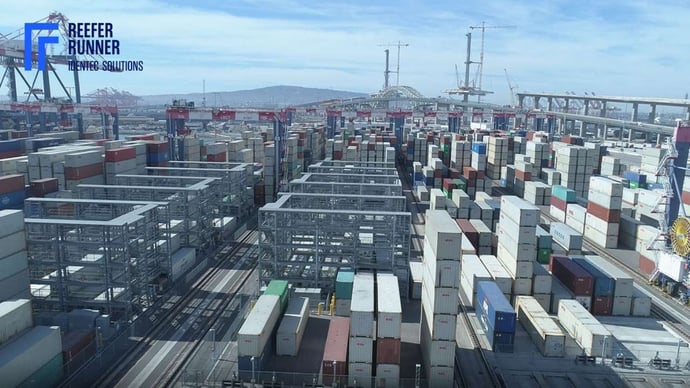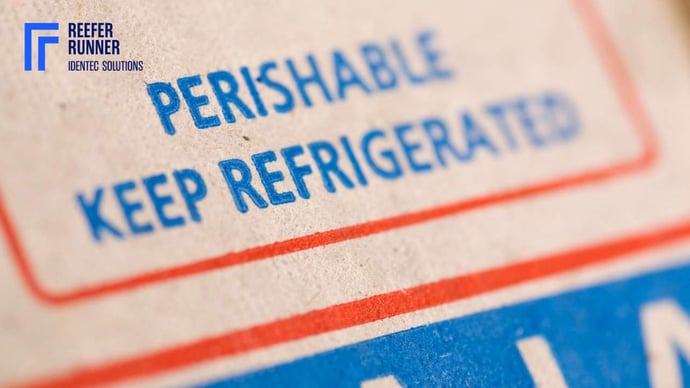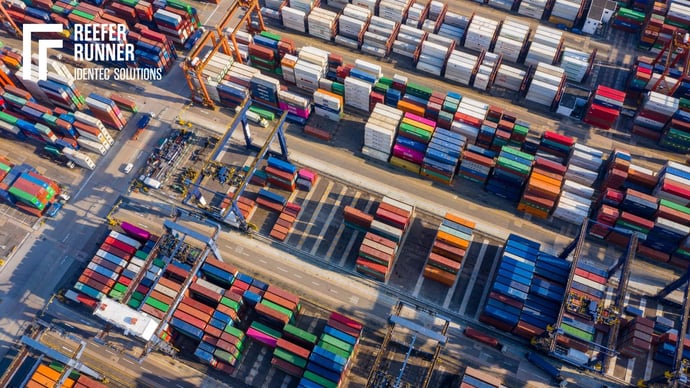Reefer Container Power Supply And the rise of energy costs
| Written by Constance Stickler
In order to be able to implement effective saving measures, it is inevitable to know exactly which areas and units in the container terminal use which amounts of electricity and at what times.
The blog post shows what to look out for when choosing a monitoring solution.
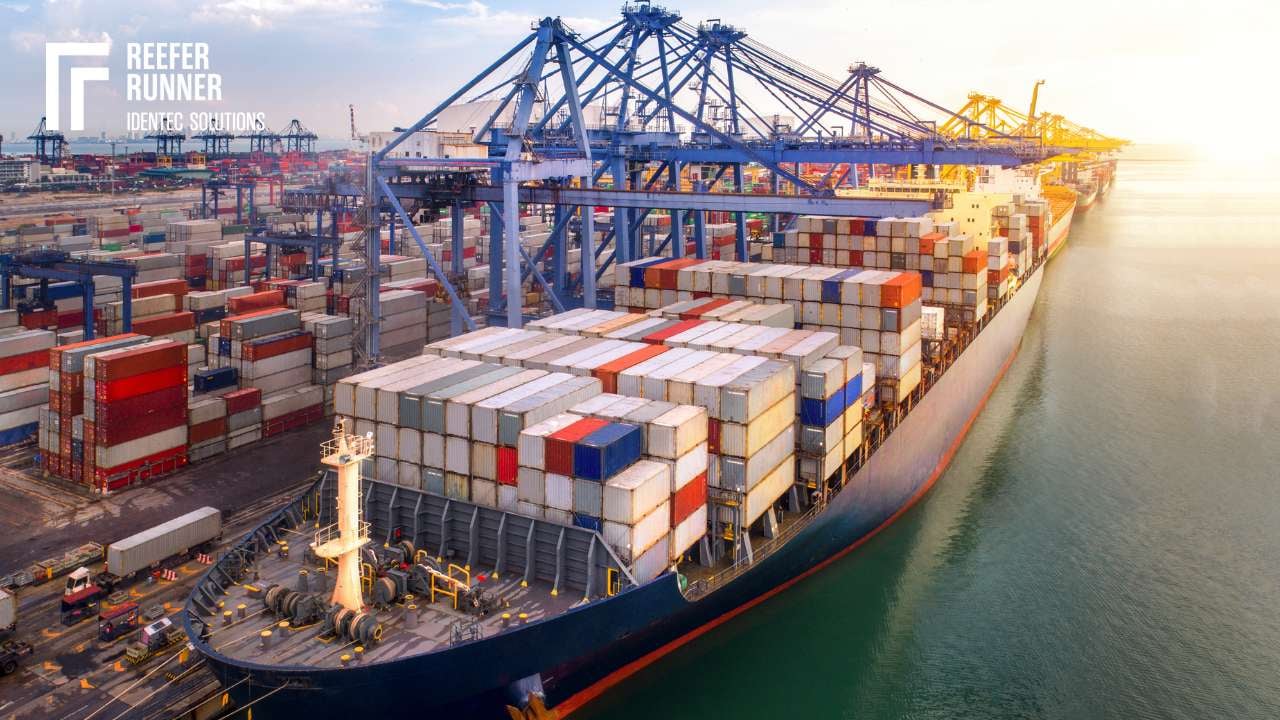
No video selected
Select a video type in the sidebar.
"Real-time tracking of energy consumption in reefer operations helps terminal operators avoid unnecessary costs and optimise energy use without compromising cargo integrity."
Wagner Pereira, Support and Sales Engineer
Ask companies how much energy they use, and most won't know. Keep asking what exactly uses how much power, and you will get even fewer answers. If this sounds familiar, it's high time to act.
After the last year's events, only some have been unaffected by the developments in energy costs, but there are considerable differences in the efforts to find solutions. Even those operators producing their energy directly at the port and are more energy-independent than others will not want to waste it. By 2030, electricity prices may rise moderately due to increased CO2 costs and reduced reliance on fossil fuels. Renewable energy expansion is expected to stabilize prices over time. (1)
The order of the day is sustainability; not only in connection with environmental protection but also with resources that have become more expensive or those whose availability can no longer be guaranteed in the foreseeable future.
Reduce, Reuse, Recycle, Refuse
The four Rs of sustainability. For our subject, the Reefer Container Power Supply, we will focus on reducing and refusing.
The best way to deal with resources is not to use them in the first place. And if so, then as little as possible. So we reduce consumption wherever and however it is feasible.
As shown by the numerous methods of CO2 compensation, the preferable way is still not to produce CO2 at all. The same applies to the consumption of energy. The energy that is not needed does not have to be generated.
The gained leeway helps us to get by with the systems available today and gives us time to expand and money to switch to renewable energies.
This brings us to the fourth R: Refuse. We should all strive to choose the most eco-friendly option and avoid polluting alternatives. If you have fewer needs and can save costs, it may be easier to refuse.
So far, so clear. But where to start? Where is any potential for savings? Well, we'll have no choice but to put on our hats, light our pipes, take Watson's hand and start the investigation.
Power consumption: Where are the leaks?
If you want a short answer: There is no way around it than consistently monitoring all your energy consumption, which provides us with an overview and marks the starting point for effective management.
Unfortunately, more than a general overview is required. Even the overview broken down by individual areas is not sufficient. To know what's going on, we need the data from each device and unit — this includes vehicles (because their electrification will eventually come) and vessels supplied by shore power.
The records must be up-to-date and genuine because only real-time data enables the most effective energy management. Those who rely on historical or wrongly assumed data will see nasty surprises. Unfortunately, this also means that the data has to be updated repeatedly: What is up-to-date today is already outdated tomorrow.
Of course, you can use manual records, which is better than nothing, but only automated solutions are reliable because they are continuous and easily accessible. Continuity is fundamental in the port's energy monitoring, as we will see later.
If not, other ways and means must be found to determine the exact value or at least extrapolate the energy consumption of individual consumers by using a similar device as a starting point. However, the data sometimes deviate quite a bit, so it is essential to calculate a buffer.
Let's summarise the most critical requirements for a monitoring solution:
- Overview of all units
- Details of each unit
- Real-time data
- Seamless data
- Reliability
- Easy access
- Easy installation
- Scalability
- Surrounding conditions
- Sustainability
- Providing other functionalities

How does Automation Imapct Reefer Power Monitoring?
Like with all repetitive tasks that should run around the clock, we will also trust the monitoring of our reefers to an automated solution. By connecting all the units to the system, we can quickly identify the total consumption of each individual unit and specific groups.
Monitoring individual reefers allows problems to be identified and resolved more quickly. Assigning multiple reefers to a group will come in handy for consumption-based billing.
The more precisely we see trends, the faster deviations become apparent and the quicker we can react. This is particularly important for peak shaving, which port operators use to control energy costs. For example, if many reefers are connected to the grid simultaneously, it causes very high power consumption in the short term (peak). If this exceeds a defined set point, prices for kilowatt hours rise exponentially. However, if you follow the current real-time consumption, you can temporarily distribute the power supply among the connections to avoid exceeding the threshold value.
Continuous monitoring shows consumption across all times of the day and weather conditions. This makes it easy to understand the effects of different measures. For example, crews may cover reefers in the yard to protect them from the sun's rays. Eventually, energy monitoring will finally prove whether this hypothesis is valid or not.
Read more about reefer operation at one of our customer's sites - Yilport.
Reefer Container Power Supply and Monitoring Costs
Automated solutions own the advantage of being very reliable and accurate. Both are crucial for planning and managing energy consumption, but it is also helpful to check your bills from the energy supplier. And it lets you review the current plan: Is it still sufficient, is a change or an upgrade needed, and are there any green power plans available that match your needs?
A prerequisite for success is access to the data. Resistance from your team will stir if these must be painstakingly collected, evaluated and put into context. However, if all data and their statements are automatically placed on a clear dashboard, you have the best chance they will be used.
Ease of access to monitor your reefer container power supply also applies to the interface's user-friendliness. The more intuitive it is, the faster energy monitoring will be integrated into daily routines. KPIs and other parameters will show you the path to optimisation (see more for reefer logistics).
One last facet of user experience is the simplest possible, ideally plug-and-play connection to your Terminal Operating System (TOS). The monitoring solution will gather specific container data and forwards them to the TOS for an updated status quo of all reefers in the yard.
The easy registration of new reefers at the TOS includes two aspects: On the one hand, the monitoring software automatically identifies and speaks with the reefer controller; on the other hand, the solution interacts with the TOS with as little effort as possible, optimally a wireless solution eliminating the need for extensive wiring.
The transponder is the missing link between the reefer and TOS. This piece of hardware does all the hard work and needs -guess what- power to be working. The transponder must rely on batteries if there is no connection to the power grid at the reefer's location in the yard. A sustainable solution has the most extended possible service life and works as energy-efficiently as possible. Excellent solutions promise a battery life of 7 and more years.
Although the economy's ups and downs over the last few months and years, the global supply chain still relies heavily on more freight by sea. A noticeable example are pharmaceutical products, where the ship's dominance increased over airfreight. More freight means more flexibility in your yard and your power monitoring solution. Therefore, friction-free scalability is a must, adding reefer plugs and infrastructure at your speed - quickly and easily.
Ports are places where things get rough. Everything is exposed to the weather, and the handling of devices is not overly cautious, so they must be designed as ruggedly as possible. So it's wise to choose a solution that has been tried and tested under these conditions. The best solution would be one that has been used at different locations for longer.
FAQ
How do newer generations of reefers help save energy?
Electricity consumption was not a major issue when older reefer models were manufactured. Modern reefer containers, on the other hand, feature cutting-edge technologies to achieve superior energy efficiency.
High-performance insulation materials such as advanced polyurethane or vacuum panels dramatically reduce thermal conductivity and minimise cooling cycles.
Newly developed refrigerants not only improve thermodynamic efficiency but also help reduce emissions of fluorinated gases (F-gases), which are potent greenhouse gases.
Variable-speed compressors can dynamically adjust cooling capacity to thermal loads, significantly minimising unnecessary energy consumption.
How to save energy costs by generating your own energy
Ports are increasingly relying on their own renewable power generation. Solar panels are particularly popular and can be easily installed on the roofs of warehouses, offices and other buildings. Wind farms on or near ports are another important source of energy. At the port of Zeebrugge, for example, 50 wind turbines generate 130 MW, while in Antwerp, there are 80 turbines with an output of 200 MW.
Ports on the sea can also use tidal and wave energy to generate electricity.
In addition to generation, energy storage is also a significant issue. Large battery plants are installed to store excess energy for later use. These efforts kill several birds with one stone: they align with global sustainability goals, make ports increasingly self-sufficient in their electricity supply and reduce costs through less or no dependence on conventional energy suppliers.
Dive deeper into one of our core topics: Refrigerated Containers
Glossary
A kilowatt-hour (kWh) is a unit of energy measurement representing the consumption of one kilowatt (1,000 watts) of power sustained over one hour. It equals 3.6 million joules or 3.6 megajoules. Kilowatt-hours are widely used to quantify energy usage in households and industries, particularly for electricity billing. For example, running a 1,000-watt appliance continuously for one hour consumes one kWh. Understanding kWh helps monitor energy consumption and compare efficiency across devices. (3)
Peak shaving refers to reducing energy consumption during periods of high demand at container terminals. This is achieved by distributing power usage across different time slots or limiting the simultaneous operation of reefer units. Peak shaving helps avoid power surges, reduces energy costs, and ensures grid stability while maintaining cargo quality. Techniques include intermittent power distribution and operating reefers within allowable temperature ranges to balance efficiency and safety. (4)
References:
(1) https://www.portofantwerpbruges.com/en/our-port/climate-and-energy-transition
(2) https://moneyweek.com/personal-finance/605440/will-energy-prices-go-down
(3) Dodge, D. (2015): So What Is a Kilowatt-Hour Anyway? Huffington Post Media Group.
(4) Van Duin, J.H.R., Geerlings, H., Oey, M.A., & Verbraeck, A. (2020): Keep It Cool: Reducing Energy Peaks of Reefers at Terminals. Delft University of Technology.
Note: This article was updated on the 9th of April 2025

Author
Conny Stickler, Marketing Manager Logistics
Constance Stickler holds a master's degree in political science, German language and history. She spent most of her professional career as a project and marketing manager in different industries. Her passion is usability, and she's captivated by the potential of today's digital tools. They seem to unlock endless possibilities, each one more intriguing than the last. Constance writes about automation, sustainability and safety in maritime logistics.
Related Articles
Related Product
